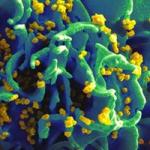
Research Topics
HIV Gene Expression, RNA Packaging, Virus Assembly, and Replication
We study how HIV generates infectious viruses and retroviruses transfers genetic information to the next generation. HIV-1 provirus utilizes host machinery to express its genes. During virus assembly, HIV-1 packages two copies of full-length viral RNA into a particle. Upon infecting a new host cell, virion RNA is used as the template to generate viral DNA, which integrates into the host chromosome to form a provirus. We study several aspects of the viral replication cycles that affect the transfer of viral genetic information, including the regulation of transcription start site usage, transport and trafficking of the viral RNA, structures and functions of viral RNA that affect gene expression, packaging of the viral RNA genome, virus assembly, and reverse transcription. We use molecular biology and biochemical approaches in combination with state-of-the-art microscopy techniques to study these topics.
HIV transcription start site usage and RNA functions. HIV-1 uses multiple transcription start sites to generate several unspliced RNA species with a few nucleotides difference at the 5' end. Despite being 99.9% identical, these RNA species differ functionally. For example, the RNA species containing one guanosine at the 5' end (1G RNA) is selected over RNA with three guanosines at the 5' end (3G RNA) to be packaged into virion as viral genome. Our studies showed that 1G and 3G RNA tend to fold into different conformations with 1G RNA structures that are less likely to interact with Gag. We have also showed that the expression of both 3G and 1G RNA are important for HIV-1 replication fitness. Mutants that express predominantly 3G (without 1G) or 1G (without 3G) have defects in replication fitness. We are currently examining how HIV-1 regulates transcription start site usage to diversify its unspliced RNA species and fulfill distinct functions.
Retroviral RNA packaging and virus assembly. In order to generate infectious viruses, HIV-1 must encapsidate full-length unspliced RNAs into its particle. To study HIV-1 RNA packaging, we have developed a novel assay to directly visualize viral RNA in the particles at single-RNA-molecule sensitivity. This assay reveals that most HIV-1 particles contain two copies of full-length viral RNA; furthermore, RNA packaging is regulated by the recognition of one dimer (two RNA molecules). Using live-cell imaging tracking individuals RNAs, we have shown that HIV-1 RNA dimerizes on the plasma membrane, the major virus assembly site, and Gag-binding stabilizes RNA dimer. We have also showed that the packaging of HIV-1 RNA can promote particle assembly. We are currently using genetic, biochemical, and imaging approaches to study the interactions between viral Gag protein and full-length RNA that lead to the encapsidation of the viral genome during virus assembly.
Retroviral RNA trafficking. Full-length HIV-1 RNA needs to traffic to specific subcellular locations to carry out its functions, including serving as a template for Gag/Gag-Pol translation and as a genome in the newly assembled virion. The functions of the viral RNA and the translated proteins can be affected when RNA is targeted to incorrect locations in the cells. Using single-RNA tracking live-cell imaging techniques, we have studies the distributions of translating and non-translating RNAs in cells. We are continuing these studies to further define HIV-1 RNA transport and its relation to the function of viral RNAs. These experiments will provide an understanding of aspects of HIV-1 replication that we currently know very little about and will allow us to better understand how HIV-1 uses the cellular machinery to traffic its macromolecules.
Reverse transcription and recombination. Recombination plays an important role in HIV replication and evolution. Many of the primary isolates of HIV are recombinants, and recombination can assort mutations to generate variants that escape host immune responses or are resistant to multi-drug treatment protocols. Additionally we have shown that recombination is required for efficient DNA synthesis during virus replication. HIV-1 recombination occurs during reverse transcription, using information in the two RNAs to produce a hybrid DNA. Therefore, phenotypically different recombinants are generated from viruses containing two copies of different RNAs. Only cells that are doubly infected can produce virions containing two different RNAs. To better understand interactions in HIV-1 populations, we study the dynamics of double infection, the frequency of recombination, and the mechanism of reverse transcription.
Biography
Selected Publications
- Chen J, Liu Y, Wu B, Nikolaitchik OA, Mohan PR, Chen J, Pathak VK, Hu WS. Visualizing the translation and packaging of HIV-1 full-length RNA. Proc Natl Acad Sci U S A. 2020;117(11):6145-6155.
- Rawson JMO, Nikolaitchik OA, Keele BF, Pathak VK, Hu WS. Recombination is required for efficient HIV-1 replication and the maintenance of viral genome integrity. Nucleic Acids Res. 2018;46(20):10535-10545.
- Chen J, Rahman SA, Nikolaitchik OA, Grunwald D, Sardo L, Burdick RC, Plisov S, Liang E, Tai S, Pathak VK, Hu WS. HIV-1 RNA genome dimerizes on the plasma membrane in the presence of Gag protein. Proc Natl Acad Sci U S A. 2016;113(2):E201-8.
- Chen J, Grunwald D, Sardo L, Galli A, Plisov S, Nikolaitchik OA, Chen D, Lockett S, Larson DR, Pathak VK, Hu WS. Cytoplasmic HIV-1 RNA is mainly transported by diffusion in the presence or absence of Gag protein. Proc Natl Acad Sci U S A. 2014;111(48):E5205-13.
- Nikolaitchik OA, Dilley KA, Fu W, Gorelick RJ, Tai SH, Soheilian F, Ptak RG, Nagashima K, Pathak VK, Hu WS. Dimeric RNA recognition regulates HIV-1 genome packaging. PLoS Pathog. 2013;9(3):e1003249.
Related Scientific Focus Areas


Microbiology and Infectious Diseases
View additional Principal Investigators in Microbiology and Infectious Diseases

Molecular Biology and Biochemistry
View additional Principal Investigators in Molecular Biology and Biochemistry


This page was last updated on Wednesday, May 28, 2025